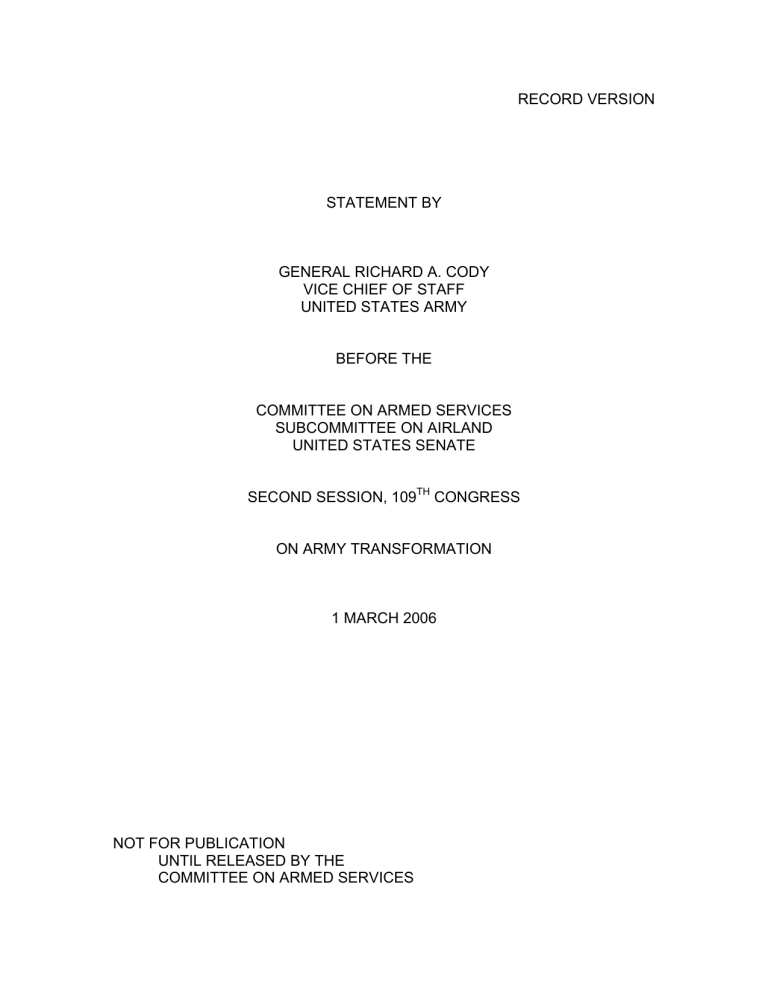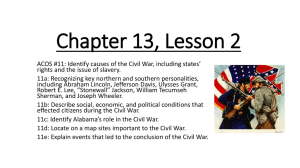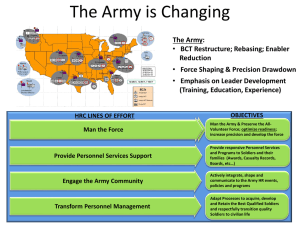RECORD VERSION STATEMENT BY GENERAL RICHARD A. CODY

STATEMENT BY
GENERAL RICHARD A. CODY
VICE CHIEF OF STAFF
UNITED STATES ARMY
BEFORE THE
COMMITTEE ON ARMED SERVICES
SUBCOMMITTEE ON AIRLAND
UNITED STATES SENATE
SECOND SESSION, 109
TH
CONGRESS
ON ARMY TRANSFORMATION
1 MARCH 2006
NOT FOR PUBLICATION
UNTIL RELEASED BY THE
COMMITTEE ON ARMED SERVICES
RECORD VERSION
STATEMENT BY
GENERAL RICHARD A. CODY
VICE CHIEF OF STAFF, ARMY
Mr. Chairman, Senator Lieberman, and distinguished members of the
Committee, thank you for this opportunity to speak to you today about Army
Transformation and the Army Modular Force. On behalf of our Secretary,
Dr. Francis Harvey, our Chief of Staff, General Pete Schoomaker, and the approximately 600,000 Soldiers on Active Duty around the world – more than
110,000 of them serving in harm’s way in Afghanistan and Iraq – let me offer a sincere “thank you” for your committed investment in our men and women in uniform. Our Soldiers appreciate the support of this committee, and your tireless work to provide them the mission-essential resources to prosecute and win the war on terrorism.
Our Army is an Army in motion. We continue to transform, to modernize, and to realign our global force posture to meet current demands and future challenges. The Army Plan is driving change at an unprecedented pace. We are aggressively evolving from a division-dependent force postured to deter and to wage war against traditional adversaries, to a modular brigade-centric force designed to meet the challenges of tomorrow’s asymmetric enemy. With your support, we have resourced and are executing a fully integrated plan to best serve the Nation, to deal with the challenges we face today and will confront tomorrow, and to sustain our volunteer Soldiers in this time of war. To execute
The Army Plan, we are depending upon continued Congressional assistance in several key areas: Expediting those wartime acquisitions essential to equipping and protecting our Soldiers; maintaining investment in emerging technologies to complete conversion to the Army Modular Force and execute the Future Combat
System (FCS) strategy; and sustaining the support of the American people whom we serve.
- 1 -
To sustain the current mission, posture for future commitments, and maintain risk at acceptable levels, the Army needs full funding of our request in the 2007 President’s Budget and supplemental funding. This supplemental funding is required for combat and contingency operations, and reset and replacement of equipment through at least two years beyond the conclusion of major operations. Prior to 9/11, many of our units, especially within our Reserve
Components, were inadequately equipped due to years of insufficient modernization investment. To meet the needs of the Combatant Commanders for the Global War on Terrorism, we had to pool personnel, vehicles, and equipment from across the force to make some units whole before they deployed.
Thanks to this Committee and the Administration, we have received unprecedented support to correct previous procurement deficits and broaden our operational capabilities to meet the complex challenges of the 21 st
century security environment. In addition, we are increasing the quality and the effectiveness of our principal fighting units, the Brigade Combat Teams (BCTs), by creating a rotational pool of 70 fully manned, equipped and trained modular
BCTs: 42 in the active component and 28 in the Army National Guard. We will support these BCTs with more than 200 active and reserve Support Brigades, organized not just for the operational fight, but to provide essential capabilities to support civil authorities in homeland defense missions, including consequence management and disaster relief.
To manage the rotation of these forces for the long war, the Army has developed a new force generation model to ensure units are at the desired state of readiness before they are scheduled to deploy. Our goal is to generate a continuous output of fully manned, equipped, and trained forces adequate to sustain one operational deployment in three years for the active component, and one operational deployment in six years for the reserve component. This model allows the Army to increase predictability for Soldiers, families, and employers,
- 2 -
improve availability of forces for Combatant Commanders, generate a continuous supply of 18-19 BCTs and the required Support Brigades, and surge up to an additional 15-19 BCTs in response to crises.
To support global operations while transforming, we are resetting our force quickly and efficiently and providing for the well-being of our Soldiers and their families. To take advantage of our current momentum, we are restoring our returning units to the required readiness levels, while simultaneously converting them to the new modular design and executing our re-stationing plan for an optimal footprint and in accordance with Base Realignment and Closure (BRAC) and Integrated Global Presence and Basing Strategy (IGPBS) decisions. We have already reset more than 20 major units. Many of these units have already returned to theaters of war in their new configurations. We are rebalancing capabilities within our three components to assure timely access to the right types of units and Soldiers. We have determined the types of units and skills that are in greatest demand in today’s security environment – including infantry, engineer, military police, military intelligence, Special Forces, chemical, civil affairs, and psychological operations – and have identified over 100,000 positions to rebalance. We have accomplished more than half of this rebalancing and project completion by 2011. To achieve heightened readiness for missions at both at home and abroad, the Army’s senior leadership is committed to fully manning, equipping, and training Reserve Component forces. This will enable them to both serve as an operational force for the Nation and a ready force for
State missions.
Equally important, the Army is moving forward on the Future Combat
Systems (FCS), our first major modernization program in more than 30 years, that simply put, is the most effective way to modernize the Army for the future.
Funding for the FCS program is critical to provide our Soldiers the means to dominate the future fight. “Spin outs” of FCS advanced capabilities will increase the combat power, versatility, and survivability of our current formations. The first
- 3 -
“spin out,” on track for delivery beginning in 2008, will introduce Unattended
Ground Sensors, Non-Line-of-Sight Launch Systems, the Intelligent Munitions
System, and the first generation Network to the force. These capabilities will enhance Soldiers' understanding of their situation in dynamic, battlefield conditions. The second and third “spin outs,” on track for delivery beginning in
2010 and 2012 respectively, will introduce new types of unmanned aircraft systems and unmanned ground vehicles for our Soldiers. These technologies will enable Soldiers to employ greater numbers of sensors to see and find their enemies first. The fourth “spin out,” on track for delivery beginning in 2014, will complete the Network. When BCTs are fielded with the full complement of FCS systems, these units will be able to generate significantly more capability. These new capabilities will directly benefit all U.S. ground forces, including the Marine
Corps and Special Operations Forces from all Services.
Even as we move forward with FCS and our many transformation initiatives, the American Soldier remains the centerpiece of all that we do. The
American military experience of the 20th century tells us that our Soldiers’ effectiveness depends upon a national commitment to recruit, train, and support them consistent with their service and sacrifices. This commitment must be underwritten by consistent investment in our recruiting and retention initiatives, in their equipment and infrastructure, and in our leader development programs.
Meeting these goals for our active and reserve Soldiers sustains the quality and effectiveness of our All-Volunteer force.
2007 will be a pivotal year for your Army. All of the Army’s initiatives –
Active Component/Reserve Component Rebalance, Army Modularity, IGPBS,
BRAC, Reset/Modernization, +30k Endstrength, Business Transformation and
Operations Iraqi Freedom and Enduring Freedom – will be fully underway, thoroughly integrated, and moving forward. The resources and commitment of this Committee will be essential to interweave and accelerate each of these components to ensure the completion of our total Army Transformation. Just as
- 4 -
important will be the support to our families, communities and the American people – truly, our extended Army family.
I assure you that our Soldiers continue to serve magnificently as we enter the fourth year of the war on terrorism. Soldiers know we are waging a long war, and they believe in their mission, the Soldier’s Creed, and the Warrior Ethos.
Our Soldiers, 150 of whom I had the honor to re-enlist in Iraq two weeks ago, continue to stay in uniform at unprecedented rates. Their voluntary service is proof of their pride in each other and their leaders, and of their unwavering patriotism. Like the American Soldiers of generations past, today’s warriors are distinguishing themselves with tremendous acts of courage and valor in places like Baghdad, Samarra, An Najaf, Fallujah, Tal Afar, Mosul, and Khandahar. Our
Soldiers understand the Army’s values and personify our Nation’s highest ideals, demonstrated most poignantly by their willingness to sacrifice all so that others may live in peace and freedom. Our Nation must remain equally committed to them by providing the resources they need to succeed in their mission. With your continued support, I know we will succeed.
- 5 -





